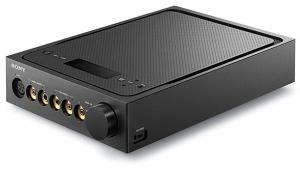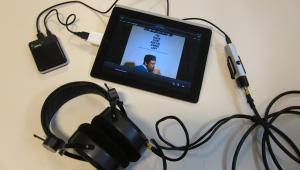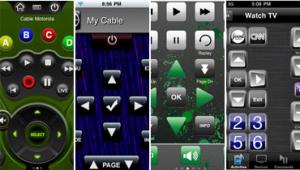mStation 2.1 Stereo Tower iPod System
My first impression of the mStation was that it had grown out of the ground. Having just uncrated it, I knew it hadn’t really sprung out of the carpet, of course. Yet somehow it seemed more like a young stand of trees than a floorstanding iPod docking system. If I waited long enough, would this self-contained trio of cylinders erupt in branches and leaves? No, and yet there was something organic about it. The pair of metal speaker tubes seemed to rise up from the base, while the subwoofer drum suspended between them seemed to levitate in midair. In addition to having a whiff of the arboreal, it also resembled a headless robot.
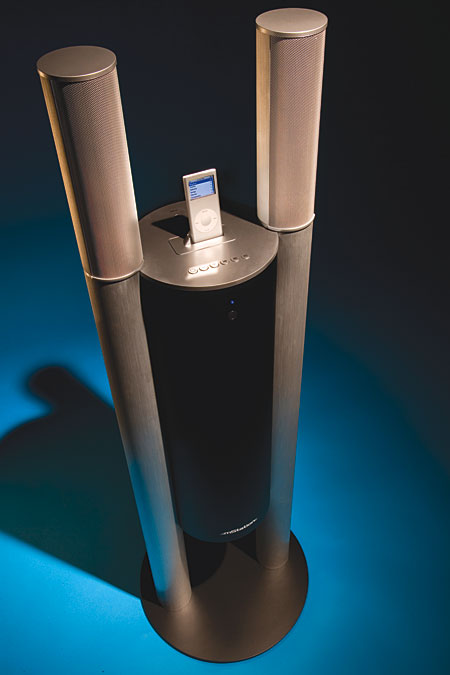
Make Mine Metal
The product is officially known as the mStation 2.1 Stereo Tower. Whether the terms 2.1 and stereo are complementary or mutually exclusive, I will leave to the reader’s discretion. The Tower is one of the company’s two products. The other is the 2.1 Stereo Orb, a 7.5-inch-wide spherical tabletop iPod system that comes in seven colors.
Makers of iPod docking systems routinely charge $300 or more for a tabletop object with a plastic chassis. By that minimal standard, the mStation Tower is generously big and well made. Every one of its 2.1 cylindrical speakers is made of extruded aluminum with a matte finish. The main channels are gray, while the sub and base are black. You look at it and think: This is cool. This is very cool.
Only the control panel on the top of the sub tube is plastic. As someone who is tired of remote controls, I would have enjoyed punching metal buttons on a solid metal surface. But given the unit’s overall quality of construction, this is a small quibble, especially since many users will ignore the control panel altogether and use the iPod or the remote to make adjustments.
In any event, the control panel includes volume up and down, track up and down, play/pause, and power-on/standby. A full power-on/off switch is behind the base of the left speaker, along with the detachable power cord. Also on the top are a line-input mini-jack and a mini-USB jack. The former accommodates non-iPod sources, while the latter connects to a PC or Mac and enables the iPod to sync with iTunes. And then there’s the dock, of course. One of my persistent complaints about iPod systems is their failure to protect the docking connector from ambient filth, so it was good to see a removable dust cover.
The controls on the membrane remote duplicate those on the front panel. But there are two significant additions—up/down buttons for both bass and treble adjustment. As I would discover later, these often come in handy, especially the bass control.
The mStation is a 2.1-way system with seven drivers. Inside the larger middle cylinder is a down-firing 5.25-inch subwoofer—or perhaps woofer would be a better term, given its size. Each of the smaller cylinders flanking the big guy contains a pair of 2-inch midranges and a single 1-inch tweeter. The tweeters are aluminum domes; the remainder are treated-paper cones. The system is biamplified, with the large driver getting 30 watts, and the speaker modules 15 watts each.
While the mStation does not come fully assembled, there is only one significant task, and that’s to install the front left and right speaker modules that jut 9 inches above the control/docking panel. Here the designers were at their most inspired. The bottom of each module contains an RCA plug in the center, surrounded by three plastic posts reinforced with screw heads. The plug fits into an RCA jack on the main unit, while the posts slide into three slots.
So long as the posts are positioned anywhere within the slots, you can rotate the speakers about 100 degrees without breaking the connection. You may choose to aim them directly forward. With the speakers 9 inches apart, measured center to center, that would provide a narrow, nearly monaural soundstage. But there’s enough wiggle room to aim them forward and outward, harnessing the reflective properties of your room’s side walls to create a wider stereo image.
While stereo separation doesn’t reach the potential of a conventional audio system with cables tethering two or more speakers, the mStation is more versatile in this respect than nearly any other one-piece iPod docking system. Chronic tweakers could happily experiment for hours, rotating the speaker modules bit by bit, supercomputer brains visualizing reflection patterns the way billiards experts plan their shots.
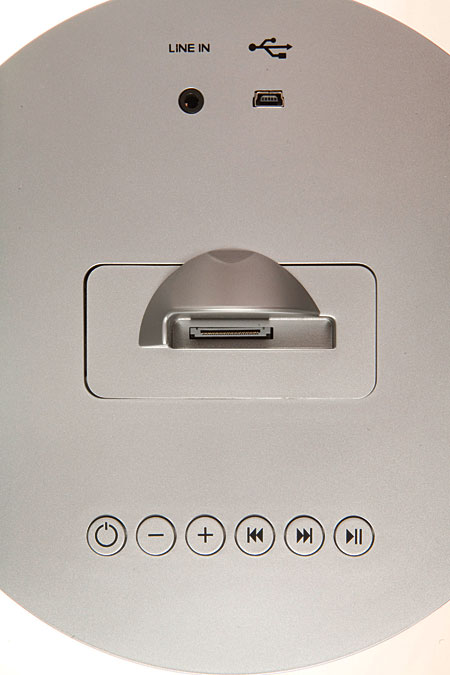
Having played all the angles, the really determined tweaker might then pick up the system and start moving it around the room—then play some more angles. All that metal notwithstanding, the mStation weighs only 21 pounds. Long-wall placement? Short-wall placement? In a corner—and if so, how far from the corner? As one of my business partners used to say, knock yourself out.
I ended up placing the system in a corner lined with CD shelving, 4 feet from one wall and 2 feet from the other, with the modules toed slightly outward. Though convenient (because it left the room’s other two systems untouched) this placement provided more bass reinforcement than the sub driver needed. Of course, I knocked down the bass. First I used the iPod’s “bass reducer” EQ setting to get the system in the ballpark. Then I made some on-the-fly adjustments using the mStation remote’s bass up/ down control.
I haven’t had so much fun setting up a review system in years.
Tubular Bells
My first impression was that the mStation sounded a lot like a generic low-cost speaker package with tubular speakers. There wasn’t much air, the midrange had some prominent coloration, and the gap in the speaker/sub crossover was all too obvious. After two long evenings of play, the system evolved, or at least my relationship with it did. The mids evened out a little, and once I figured out what to do about the bass, I began to regard the system’s idiosyncrasies as normal.
The mStation could certainly rock out. Playing through Exile on Main Street by the Rolling Stones, I was pleased with the sassy horn charts of “Rocks Off,” tapped my foot to the valuable advice given in “Sweet Virginia,” and found “Ventilator Blues” no murkier than usual. In general, I enjoyed a genuinely pleasurable, if not quite definitive, Stones experience. A definitive one would replace MP3 with vinyl.
Classical music was variable. Strings and piano, recorded in a relatively nonreverberent fashion, tended to come off bright and clattery, as in the otherwise excellent EMI set of Tchaikovsky, Prokofiev, and Bartók piano concertos with soloists Emil Gilels and Sviatoslav Richter, conductor Lorin Maazel, and various orchestras. However, a just slightly darker-toned recording like Vladimir Ashkenazy and Andre Previn’s three-CD set of Prokofiev piano concertos for Decca emerged in relatively good shape and could be played a little louder. The system just loved a relic of my pilgrimage to Prague—Rachmaninov’s Complete Works for Cello and Piano with cellist Jan Pálenícek and pianist Jitka Cechová (Lotos). But what system wouldn’t?
The mStation commands its niche with a long list of practical advantages. Some of them are remarkable—especially the small footprint, the pivoting satellite modules, and thus the ability to fit into just about any part of any room. I don’t see the mStation replacing a primary music system. But I do see it bravely bringing music into rooms that are small, rooms that have too much to do, and especially the no-hope acoustic nightmare of an exurban house’s “great room,” with its yawning open-plan gaps and musically hostile hard surfaces.
This product will find its audience among those who have no patience for conventional speakers, are not willing to cut holes in walls, want something better than a tabletop system, and don’t mind saving a buck. If that sounds like you, the mStation might become the beacon of your casual-listening life.
Highlights
Floorstanding iPod tower
Unique form factor
Built-in subwoofer


